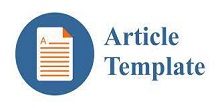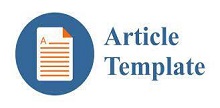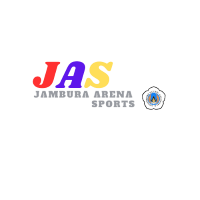Author Guidelines
JAS : Jambura Arena Sport provides a forum for academics, researchers and practitioners to publish scientific articles. All texts sent to the JAS editorial team are accepted in Indonesian. Make sure your paper is prepared using the JAS Template. A maximum of 10 pages can be created (final edit)
1. General Guidelines Manuscripts are typed using the MS program. Word (Times New Roman 12 pt font), A4 paper size (21x29.7cm), using 2 cm margins on all sides, 1 space, maximum 10 pages including tables and figures and each page of the manuscript is numbered sequentially. Illustrations of research data in the form of images can be in the form of maps, photos, flow diagrams, nerves, or charts. Images or tables can be placed in text boxes placed at the top or bottom of the page. The data in the table is arranged logically so that the information conveyed can be understood correctly. Tables are numbered sequentially with the title and table number above the table. Equations must be numbered in parentheses. Equations must be prepared using equations (not in image format). The equation number must be placed on the right side. Submission of manuscripts is done online via the JAS Journal website by registering first. The website address is https://ejurnal.ung.ac.id/index.php/jas/login . If you have difficulty uploading your manuscript online, you can contact the JAS Editorial Team via email: [email protected] or wa/tlp: 0821-8878-0104
2. The preparation of the manuscript must contain at least the following material: title, author's name, affiliation and address, abstract in English and Indonesian, introduction, methods, results and discussion, conclusion, thanks (optional), references.
ï¶ Title. Describe the main content of the text concisely and clearly in a maximum of 14 words, written in Indonesian for Indonesian and English texts. Author's full name. Written in full (not abbreviated) and without a title. Author's full address. Full name of institution, author's hometown, and institution's mailing address city, zip code, and state
ï¶ Abstract Maximum 200 Indonesian words in italics with 11 point Times New Roman. The abstract must be clear, descriptive, and provide a brief description of the research problem being conducted/researched. The abstract contains the reasons for selecting the topic or the importance of the research topic, research methods, and a summary of the results. The abstract should end with comments about the importance of the results of a brief conclusion.
ï¶ The introduction contains background, problem formulation, activity objectives, and literature review. Writers are required to quantitatively present portraits, profiles and conditions of the target audience involved in research activities. Who can also describe the situation and potential of the area from a physical, social, economic and environmental perspective that is relevant to the activities carried out. Also explain the potential that can be used as material for research activities. Authors are asked to formulate the problem concretely and clearly in this section. Explain the objectives to be achieved in research activities. This section is supported by a review of the literature used to support the service concept. Authors are required to present a preliminary (references to journal articles and conference proceedings) and up-to-date (references published within the last five years) literature review. The literature review is not limited to theory but also empirical evidence. Enrich this introductory section with efforts that others have made. This article is the result of research; It could be the results of your research or other researchers.
ï¶ Methods: In the application methods section, the methods used to achieve the goals set out in the research activities are explained clearly and concisely. Service results must be measurable, and the author was asked to explain the measuring tools used, both descriptively and qualitatively. Explain how to measure the level of success of research activities.
ï¶
Results and Discussion Research is an effort to disseminate science, technology and sports. These activities must provide added value for researchers, both in economic activities, policies and behavior (social) change. Describe that research activities have provided changes to individuals and institutions in both the short and long term. This section explains how activities are carried out to achieve the goal. Explain the indicators for achieving goals and benchmarks used to declare the success of research activities carried out. Reveal the external advantages and disadvantages or the main focus of the action when viewed from the researcher's conditions at the activity location. Also, explain the difficulties in carrying out activities and producing goods and opportunities for future development. Who can strengthen the articles with relevant documentation regarding services or goods as the main output or focus of activities? Documentation can be in the form of implementation or implementation process images, product prototype images, tables, graphs, etc.
ï¶ The conclusion should indicate the results obtained, advantages and disadvantages, and possibilities for further development. Conclusions can be in paragraph form but must be in point form using numbering or bullets.
ï¶ Acknowledgments include the names of agencies that have contributed to helping carry out the research. Also, include the name of the research funding agency.
ï¶ BIBLIOGRAPHY
All references referred to in the text of the article must be listed in the Bibliography section. The bibliography must contain reference libraries originating from primary sources (scientific journals and amounting to a minimum of 80% of the entire bibliography) published in the last 10 (ten) years. Citations are arranged and written based on a number system according to the order of citation, following the Vancouver citation style. Only references cited in the article are included in the Bibliography. It is highly recommended to use Mendeley Reference Manager by selecting Indonesian as the citation language. Some examples of how to write references in the Bibliography are given below.
1. Triayuni Hartati EMP. Karakteristik Teori-teori Pembelajaran. J Penelitian, Pendidik dan Pengajaran [Internet]. 2023;4(1). Tersedia pada: https://jurnal.umsu.ac.id/index.php/JPPG/article/view/13431
2. Febu Dwi Haryanto CA. Media Pembelajaran dengan Menggunakan Permainan Ular Tangga Berbasis WEB. J Tek Komput AMIK BSI [Internet]. 2015;1(2). Tersedia pada: https://ejournal.bsi.ac.id/ejurnal/index.php/jtk/article/view/260
3. Arisandiyessi & Sepriadi. Pelaksanaan Pembelajaran Pendidikan Jasmani dan Olahraga Kesehatan di Sekolah Dasar. J Pendidik Olahraga [Internet]. 2023;6(1):54. Tersedia pada: http://jpdo.ppj.unp.ac.id/index.php/jpdo/article/view/1277
4. Rahmat Permana. Efektivitas Metode Pembelajaran Pendidikan Jasmani Play Tech Play Terhadap Peningkatan Kebugaran Siswa Sekolah Dasar. Nat J Penelit Pendidik dan Pembelajaran [Internet]. 2018;5(1):294–302. Tersedia pada: https://scholar.archive.org/work/zsm3s4mmhvbb3anukhctyufade
5. Martin Sudarmono(1), Lulu April Farida(2) RBAP. Pengembangan Permainan Team Sports untuk Pembelajaran Pendidikan Jasmani, Olahraga, dan Kesehatan Siswa Sekolah Menengah Atas. J Penelit Pendidik [Internet]. 2015;32(2). Tersedia pada: https://journal.unnes.ac.id/nju/index.php/JPP/article/view/5712
6. Kustandi C dan BS. Media Pembelajaran; Manual dan Digital. Bogor: Ghalia Indonesia; 2011.
7. Kore, D., Wondal, R., & Samad R. Peran Permainan Ludo Dalam Mengembangkan Kemampuan Kognitif Anak Usia 5-6 Tahun. J Ilm Cahaya Paud [Internet]. 2020;2(1):106–16. Tersedia pada: https://www.neliti.com/publications/383031/peran-permainan-ludo-dalam-mengembangkan-kemampuan-kognitif-anak-usia-5-6-tahun
8. Kristiani D. Ensiklopedia Negeriku (Permainan Tradisional). Jakarta: Bhuana Ilmu Populer; 2015.
9. Mulyani N. Super Asyik Permainan Tradisional Anak Indonesia. Yogyakarta: Diva Press; 2013.
10. Visca Elya Anastasya, Ristiyani dan NF. Permainan Ludo Sebagai Upaya Meningkatkan Kemampuan Berfikir Kreatif Siswa Sekolah Dasar. . WASIS J Ilm Pendidikan [Internet]. 2021;2(1):9–14. Tersedia pada: https://scholar.archive.org/work/bo2npvbtmvepna54xk7umkbyxe
11. Arikunto S. Pengembangan Instrumen Penelitian dan Penilaian Program. Yogyakarta: Pustaka Pelajar; 2017.
12. Suzuki Syofian, Timor Setiyaningsih NS. Otomatisasi Metode Penelitian Skala Likert Berbasis Web. Pros Semin Nas Sains dan Teknol [Internet]. 2015; Tersedia pada: https://jurnal.umj.ac.id/index.php/semnastek/article/view/540




















